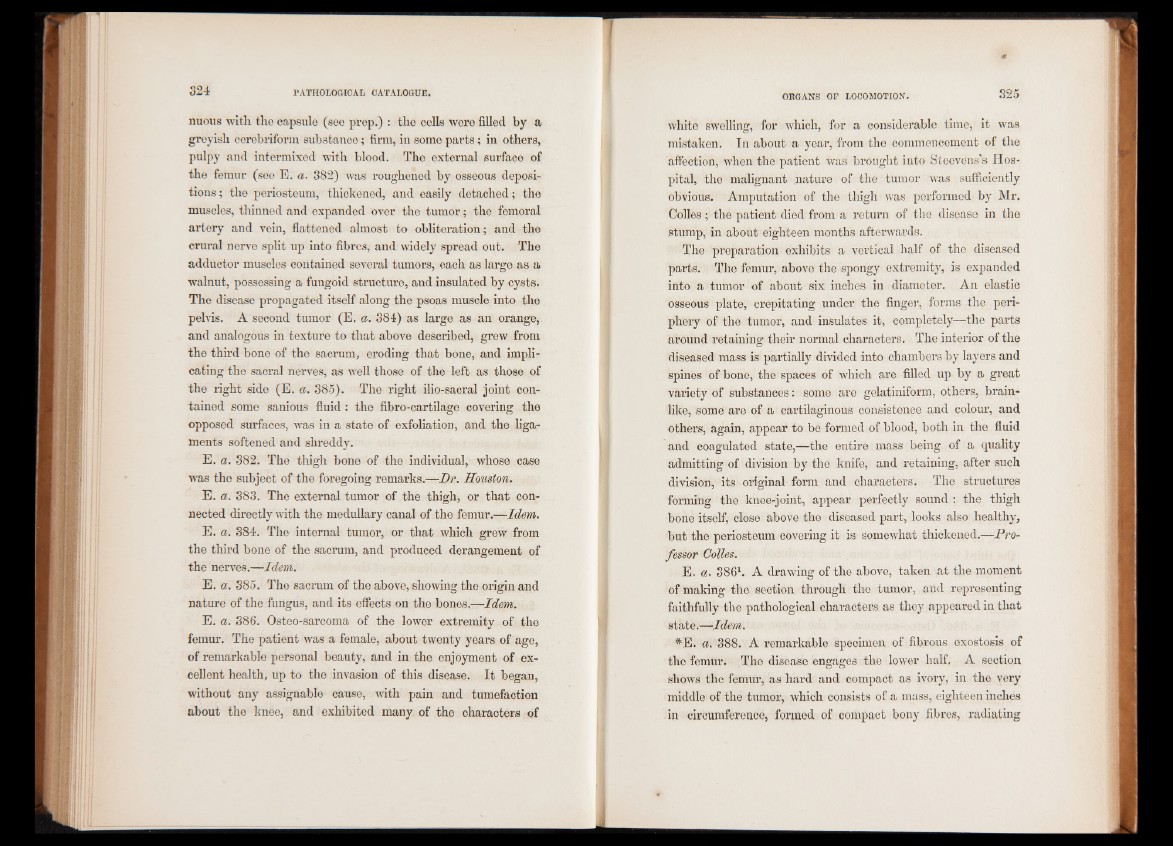
nuous with the capsule (see prep.) : the cells were filled by a
greyish cerebriform substance; firm, in some parts; in others,
pulpy and intermixed with blood. The external surface of
the femur (see E. a. 382) was roughened by osseous depositions
; the periosteum, thickened, and easily detached; the
muscles, thinned and expanded over the tumor; the femoral
artery and vein, flattened almost to obliteration; and the
crural nerve split up into fibres, and widely spread out. The
adductor muscles contained several tumors, each as large as a
walnut, possessing a fungoid structure, and insulated by cysts.
The disease propagated itself along the psoas muscle into the
pelvis. A second tumor (E. a. 384) as large as an orange,
and analogous in texture to that above described, grew from
the third bone of the sacrum, eroding that bone, and implicating
the sacral nerves, as well those of the left as those of
the right side (E. a. 385). The right ilio-sacral joint contained
some sanious fluid: the fibro-cartilage covering the
opposed surfaces, was in a state of exfoliation, and the ligaments
softened and shreddy.
E. a. 382. The thigh bone of the individual, whose case
was the subject of the foregoing remarks.—Dr. Houston.
E. a. 383. The external tumor of the thigh, or that connected
directly with the medullary canal of the femur.—Idem.
E. a. 384. The internal tumor, or that which grew from
the third bone of the sacrum, and produced derangement of
the nerves.—Idem.
E. a. 385. The sacrum of the above, showing the origin and
nature of the fungus, and its effects on the bones.—Idem.
E. a. 386. Osteo-sarcoma of the lower extremity of the
femur. The patient was a female, about twenty years of age,
of remarkable personal beauty, and in the enjoyment of excellent
health, up to the invasion of this disease. It began,
without any assignable cause, with pain and tumefaction
about the knee, and exhibited many of the characters of
white swelling, for which, for a considerable time, it was
mistaken. In about a year, from the commencement of the
affection, when the patient was brought into Steevens’s Hospital,
the malignant nature of the tumor was sufficiently
obvious. Amputation of the thigh was performed by Mr.
Colies; the patient died from a return of the disease in the
stump, in about eighteen months afterwards.
The preparation exhibits a vertical half of the diseased
parts. The femur, above the spongy extremity, is expanded
into a tumor of about six inches in diameter. An elastic
osseous plate, crepitating under the finger, forms the periphery
of the tumor, and insulates it, completely—the parts
around retaining their normal characters. The interior of the
diseased mass is partially divided into chambers by layers and
spines of bone, the spaces of which are filled up by a great
variety of substances: some are gelatiniform, others, brain-
like, some are of a cartilaginous consistence and colour, and
others, again, appear to be formed of blood, both in the fluid
and coagulated state,—the entire mass being of a quality
admitting of division by the knife, and retaining, after such
division, its original form and characters. The structures
forming the knee-joint, appear perfectly sound : the thigh
bone itself, close above the diseased part, looks also healthy,
but the periosteum covering it is somewhat thickened.—Professor
Colies.
E. a. 3861. A drawing of the above, taken at the moment
of making the section through the tumor, and representing
faithfully the pathological characters as they appeared in that
state.—Idem.
#E. a. 388. A remarkable specimen of fibrous exostosis of
the femur. The disease engages the lower half, A section
shows the femur, as hard and compact as ivory, in the very
middle of the tumor, which consists of a mass, eighteen inches
in circumference, formed of compact bony fibres, radiating